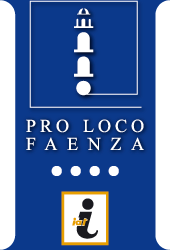- Visit Faenza
Places to see
- Accommodations
- Food and drink
- Events
- Guided tours
- News
- Ceramics
- Pro Loco Faenza
Useful infos
- City map
- City history
- Churches, monuments
- Museums
- Parks and gardens
- Essential informations for major monuments
- Routes
- Book a guided tour of the city
- Romagna Visit Card
- Palio of Niballo and Rioni
- Cultural activities
- Leisure
- Historical shops
- Twin towns
- Getting here
- How to move in the city
- Useful phone numbers
- Other useful informations
- Links

The most important medieval church of Faenza, founded in the XII century and still conserving 1200’s and 1300’s parts.
The Commenda was probably founded in the first half of the XII century (the first sure document dates back to 1137), even if the more ancient parts that can be seen today date to the 1200’s (apse and part of the bell tower) and the 1300’s (portico for thepilgrims on the left side). It was erected together with the adjacent Santo Sepolcro Home for accommodating pilgrims headed for or coming from the Holy Land. Already in the XIII century it became the property of the Cavaliers of the order of San Giovanniof Jerusalem (then of Malta), who ran it always through the Commendators, or abbots to whom the building was in the care of, also economically. The most enlightened among the Commendators was the Milanese Fra Sabba da Castiglione (1480? - 1554), a humanist scholar who promoted restoration works and called various artists to work. For the former, there is the renovation of the adjacent cloister in 1525 and for the latter there is the great fresco of the apse basin, commissioned by Fra Sabba for Girolamo da Treviso in 1533, who was passing through Faenza. This remains the most fascinating artwork of the Commenda, where there appear – set in an architectural prospective of refined renaissance taste, with background countryside – three women (the Virgin withChild and San Giovannino, S.Maria Maddalena with the Sepulchre ointment at her feet and Santa Caterina d'Alessandria with the cogwheel the symbol of her martyrdom). Adoring them on the left, is Fra Sabba on his knees in his “uniform” of warrior monk: renaissance tunic, helmet and sword.The other important artwork is on the left wall and consists of an extremely delicate monochrome fresco, with the now aged Fra Sabba, presented to the Virgin by San Giuseppe (patron of good death), whilst on the left there are the Baptist and Mary Magdalene. Underneath is his tomb slab in black stone, with a moving Latin epigraph he composed himself and to the sides, the happy figures of the Pieta and the Silenzio, work by Francesco Menzocchi of Forli’ dating to just before 1554, the year Fra Sabba died. On the walls there are interesting fragments of frescoes of the local 1300’s school.
Other images on faenzafoto.it
- Address
Piazza Frà Saba
48018 Faenza RA - Web: www.comune.faenza.ra.it/Citta/Gallerie-e-luoghi-d-arte/Musei/Chiesa-della-Commenda
- Area: Center
- Opening:
9.00/19.00 - Map:
Graphics - HTML: Caterweb
Developed by: CicoNET
CMS: Web Portal Now
All CREDITS











